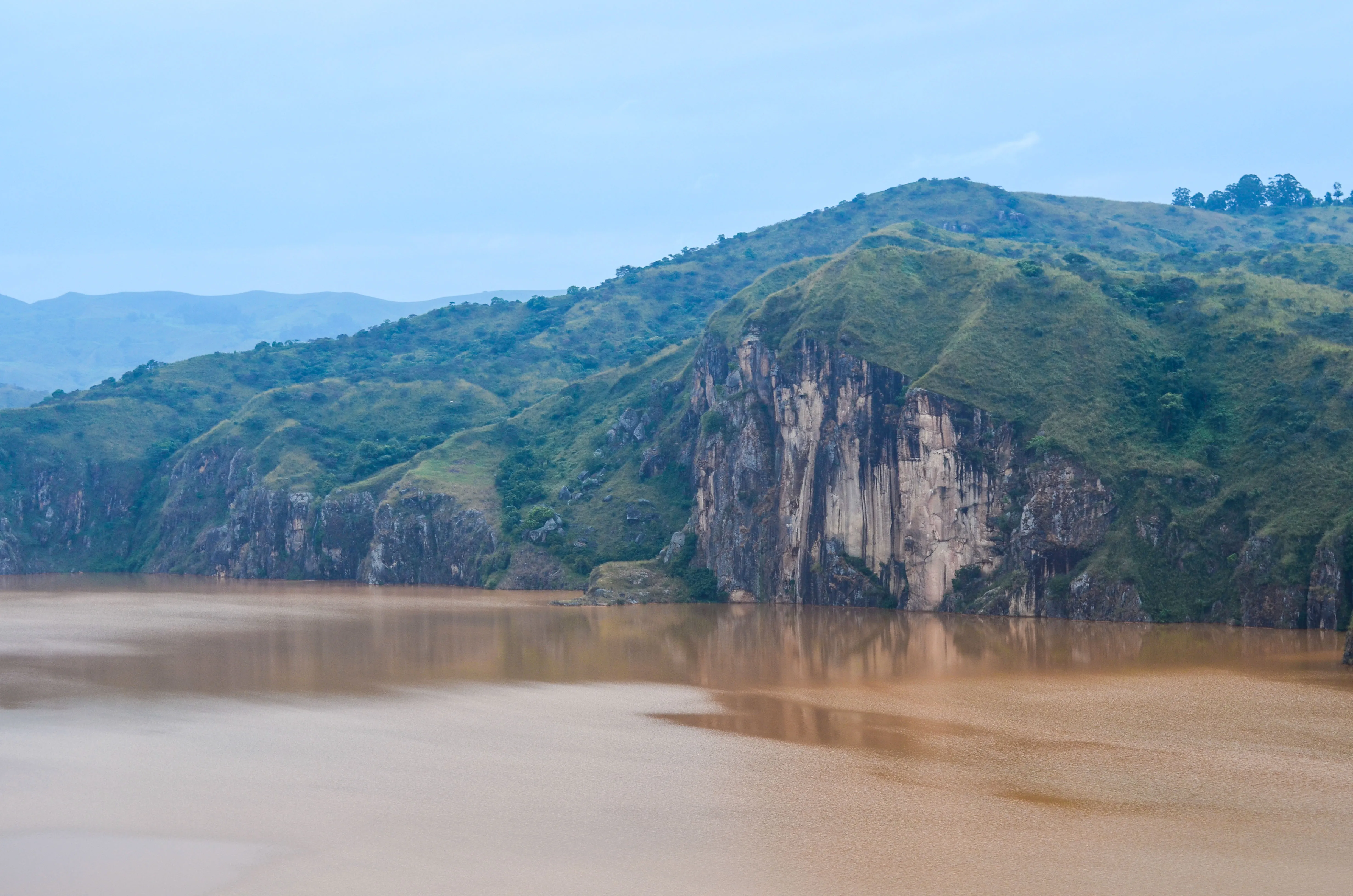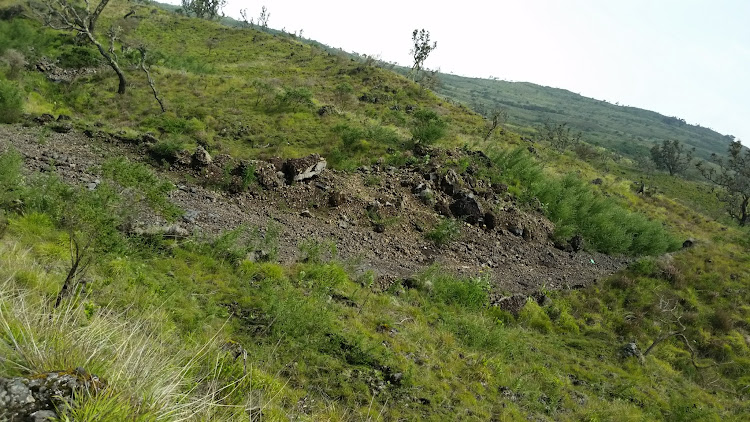
•Killer Lake Nyos
The Nyos “Killer Lake” Eruption Disaster 1986
It is an ordinary day for Doctor Emmanuel Ngu Mbi on August 22, 1986. The chief of the Subum villages’s health center in North West Cameroon has spent the previous day in a nearby town and is traveling back home on his bicycle. The morning trip is no different from any other Mbi has taken before. However, he will remember this journey for the rest of his life. It all starts when Mbi bumps into a dead antelope. He doesn’t find it too unusual, he ties the antelope to his bike and carries on. But, as he continues his journey, Mbi notices more dead animals lying by the roas. Now, this is an unusual sight. The doctor rushes to the tiny village of Nyos near the lake of the same name to find answers. What he finds instead is a horro-movie-like scene. Dead villagers are lying all over the place as if some invisible force has killed them. There is not a single living soul to find. Mbi is both bewildered and frightened. What he didn’t know was that a veil of death had spread across the entire Lake Nyos valley, killing more than 1700 people. What he initially thought to be an oddity was an event that triggered the attention of the whole world, aiming to reveal what caused this mysterious tragedy.
Flustered by what he saw, Mbi rushed back to Wum, where he work a night before, to report the disaster he witnessed to his superiors. The word of the peculiar event spread to the Governor of the North West Region and quickly reached the president, Paul Biya’s office. Biya ordered immediate action, but Lake Nyos is located in the remote northwestern part of the country. Subsequently, it took two days for the Cameroonian Army troops and medical teams to reach the villages caught in the disaster. Once they arrived, they too found an apocalyptical scene. Most affected were the villages of Nyos, Subum, and Cha. Dead bodies were scattered all over the settlements. While some of the deceased were lying around the huts, others were found in nearby streams and further in the forest, indicating they were running away from something.
Contrary to them, other victims were found lying in their beds as if they never knew what hit them. They all had their clothes covered with these puzzling greasy red stains and seemed have died from suffocation. Livestock, and even insects were all decimated by this mysterious source of death. All in the valled was extinguished, with nothing indicating the source. The period of initial shock didn’t last long. Due to fear of an epidemic, the government ordered all bodies to be buried in mass graves as soon as possible. For days and nights, soldiers dug burial pits, not even counting the number of bodies they buried. Further from them, army bulldozers dug giant holes to dispose of dead animals.
Some 300 people that survived the disaster required urgent treatment and were transferred to the hospital in the nearby town of Nkambe. Survivors suffered from dizziness and breathing problems and had skin lesions similar to burnings. Curiously, most of those who escaped death were farmers on the hills above the main villages. At the same time, the government started a massive relocation campaign for locals. Whatever the reason behind the disaster the authorities feared, it could still impact people’s health and lives. For this reason, it decided to seal the area off. More than four thousand people were relocated to temporary resettlement camps in the first week after the disaster. For half of them, the resettlement became a permanent measure, as their lives back home no longer existed. Soon, the scale of the disaster caught the attention of the international community, large shipments of food and medical supplies from around the world were sent to Cameroon. International medic teams arrived to help treat the injured.
A group of American scientists also went to the country, but for a different reason. They were attracted by the peculiarity of the event and wanted to discover what caused such an unprecedented and, above all, mysterious tragedy. Their discovery was a surprise no one expected. It made the Lake Nyos disaster one of the strangest in the history of humankind. For the local population, there was no doubt. The lake was cursed!!! Three years before the disaster, a prominent tribe chief named the Lake Chief had died. On his deathbed, the late chief designated his best cow to be used for ritual sacrifice. After his death, however, the chief’s relatives were reluctant to give away their best cow and substituted it with a smaller one. It was believed that from the afterlife, the late chief was furious, and the disaster resulted from his wrath!
The scientists, too, believed the lake had something to do with the disaster but were not so convinced by the might of the late chief. The first lead in discovering the roots of the tragedy was the fact that the majority of the deceased lived within the 12-mile (19 kilometer) area along the valley running east and west of Lake Nyos. The further the scientists went from the lake, the lower the number of casualties. Their doubts were supported by the survivors, who testified that on the night of the tragedy, they heard a series of rumbling sounds coming from the lake. The thunder lasted for a few minutes and was followed by a strong odor similar to gunpowder or rotten eggs. For most witnesses, that was the last thing they remembered as they fell unconscious and didn’t wake up until the next day. In the end, the lake’s appearance assured the scientists that something strange had happened to it. Lake Nyos, known for its clear blue color, was completely red. To make things more clear, Lake Nyos is different; It’s a crater lake that is formed on the top of an inactive volcano, in the Oku volcanic plain. With its bed connected to a large magma chamber beneath the ground. Lake Nyos is one of the three lakes in the world known to be saturated with carbon dioxide. Like most lakes, it is thermally stratified which means it has a layer of warm water floating on a layer of colder, denser water. In typical lakes, there layers mix due to changes in their temperatures caused by rain, cold weather, and wind blowing across the water surface.
However with the case of Lake Nyos, because of the tropical climate conditions, the temperature of the water is unusually consistent from the surface to the bottom. As a result, layers don’t mix, which stops the carbon dioxide on the bottom of the lake from reaching the surface and escaping into the air. Instead, it accumulate and is dissolved in the water due to high pressure at the bottom of the lake. Now, there is a limit for the carbon dioxide accumulating at the bottom of the lake. When it becomes too high, it rises to upper levels and comes out of the solution due to lower pressure. It only takes a minor disturbance to carbon dioxide to burst to the surface and out into the air, causing the so-called “limnic eruption.”
Test water samples taken from Lake Nyos showed abnormally high levels of carbon dioxide, a piece of evidence pointing to limnic eruption. The red color of the lake was further proof in support of the claim; it turned out to be dissolved iron. Only limnic eruption could bring iron sediments to the surface after being stirred up from the bottom of the lake.
A similar eruption occurred on August 15, 1984, in Lake Monoun, eighteen miles (30Km) from Lake Nyos. The scale of the disaster was far lower, though, with 34 people killed. Years after the incident, some European scientists claimed that the Lake Nyos disaster resulted from a gas-rich volcanic eruption. Still, the theory was overthrown by a series of studies supporting the limnic eruption. Based on the calculations made by the scientists, the limnic eruption of Lake Nyos was one of horrifying scale. It released about 100,000 – 300,000 tons or 1.2 cubic kilometres (1,2 km3) of carbon dioxide into the air. In addition, the eruption created a 330 ft (100m) tall column of water and an 82-feet-tall (25m) wave that swept the lake shore. The eruption released other gasses from the lake as well such as sulphur dioxide and hydrogen sulphide, hence the smell of rotten eggs that the survivors reported. The released carbon dioxide formed a 160 ft (50m) thick cloud of gas that spread across the valley at the speed of 12 to 30 miles per hour (20-50 Km/h). Even though carbon dioxide is present in the air we breathe, it can still be toxic in higher concentrations. Being a heavier compound, it completely displaces the oxygen the human body needs. Without oxygen, the human organism slows down and does not function properly. An air mixture containing 10 percent of carbon dioxide can cause convulsions, comas, and death. Imagine 300,000 tons of carbon dioxide spreading across the Lake Nyos valley. The chances of survival were minimal. The result of the limnic eruption was devastating. No physical damage was done in objects in the area, but most life was destroyed. The U.N. Disaster Relief coordinator in Geneva put the final death toll at 1,746, even though the number might be much higher. Around 3,500 livestock were also killed, making the disaster a complete humanitarian catastrophe.
Years after, one thing that baffled the scientists was what initiated the eruption. There are several theories, including a landslide, an earthquake, and a cooling of the upper layer of water by massive rainfall in days before the disaster. However, there is no clear evidence of what triggered the carbon dioxide eruption to date. The only conclusion the scientists could make was that Lake Nyos was again accumulating carbon dioxide. With the mechanism behind the gas eruption still unknown, disaster could strike again. When it comes to how to prevent future eruptions, scientists came up with a surprisingly simple, but life-saving, solution. After the disaster, scientists spent ten years trying to find a solution to avoid a repeat event. The most promising solution was to install platforms with degassing tubes. The mechanism consisted of tubes reaching just above the lake floor and a water pump. The pump would lift the water saturated with carbon dioxide from the bottom to the surface. Once the pressure is low enough, the carbon dioxide would come out of the solution and safely spread into the open air.
The first tube was installed in 1995 and assured the scientists the plan might work. Another tube was installed in 2001, and two more in 2011. The system allowed releasing the amount of carbon dioxide equivalent to the amount of gas that accumulates at the bottom of the lake. It was simple yet effective way to prevent a new disaster similar to one in 1986.
Today, Lake Nyos still has the same iron-red color it turned after the limnic eruption. The lake valley lies empty with ruins of once prosperous villages.
References
1. https://try.magellantv.com/darkhistory
2. Google photo by Koko Budiyanto
Subscribe to Our News Letter

